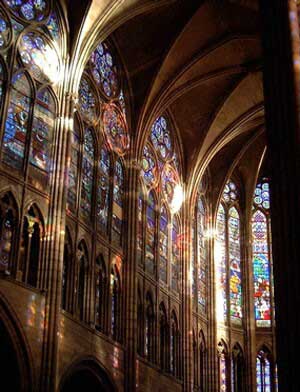 |
Symbolism
The Cathedral: Symbol of Paradise
Hugh O’Reilly

The southwest nave of St. Denis Basilica in Paris |
The Cathedral is a figure of the City of God, the Celestial Jerusalem, an image of Paradise, as the liturgy of the consecration of churches affirms.
Its lateral walls are representations of the Old and New Testaments. Its pillars and columns are the Prophets and Apostles that sustain the cupola, where Christ is the center. The stained-glass windows that separate us from the storms and let the light pour over us are the Doctors. The threshold is the entrance to Paradise embellished by stone statues, painted and gold bas-relief sculptures, and rich bronze doors.
The House of God must be illuminated by the rays of the sun, resplendent with charity like Paradise itself, because God is Light, the light Who gives beauty to everything that exists. For this reason the internal illumination of the cathedral should be augmented, making the windows as large as possible, from the top of the great arches to the cupolas.

Based on Marcel Aubert
Le Gothique à son apogee, p. 22

Related Topics of Interest
 The Middle Ages, a forest filled with symbols The Middle Ages, a forest filled with symbols
 Requiescant in pace... Burial customs Requiescant in pace... Burial customs
 The symbol of the sword The symbol of the sword
 The fidelity of the remnant throughout History The fidelity of the remnant throughout History
 Gargoyles and original sin Gargoyles and original sin
 Virtue and vice symbolized in animals Virtue and vice symbolized in animals
 Votive light, fire and candles Votive light, fire and candles

|
Symbolism | Religious | Home | Books | CDs | Search | Contact Us

© 2002- Tradition in Action, Inc. All Rights Reserved
|
 |
|